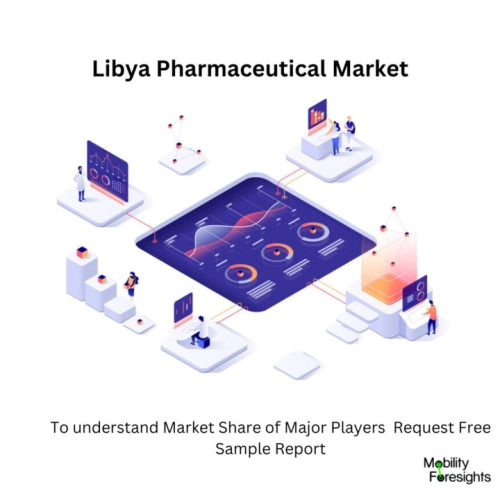
- Get in Touch with Us

Last Updated: Jun 02, 2025 | Study Period: 2024-2030
The private sector powerfully contributes to providing better-quality health services. It covers services ranging from hospitals, clinics, and laboratories to medicines, vaccines, and other services such as ambulances and insurance.The Libyan healthcare sector has come a long way and still has a lot of room for growth and improvement. The role of private sector companies, such as AlSahl Group Holding, in providing quality healthcare services and products is commendable.
Collaboration between international organizations and the Libyan government is also crucial in addressing the sector's challenges, upgrading infrastructure, improving access to health services, and managing public health emergencies. The Libyan pharmaceutical market is dominated by generics, which account for over 80% of the market. However, there is a growing demand for branded medicines, particularly in the areas of oncology, diabetes, and cardiovascular diseases.
The main distribution channels for pharmaceuticals in Libya are pharmacies, hospitals, and public health facilities. However, there is a growing trend of online pharmacies and drug delivery services. The Libyan pharmaceutical market is highly fragmented, with a large number of small and medium-sized enterprises (SMEs) operating in the market. However, there is a trend of consolidation, with a number of larger companies acquiring smaller players.
Libya Import data, Pharmaceutical import shipments in Libya stood at 2.1K, imported by 198 Libya Importers from 110 Suppliers.The top three importers of Pharmaceuticals are India, with 501,461 shipments, followed by the United States, with 226,324 shipments, and Pakistan, with 204,667 shipments.
The pharmaceutical industry in Libya has evolved over time, primarily due to the Libyan government's investment in the health system and pharmaceutical industry, which has resulted in the establishment of public pharmaceutical companies and the construction of new factories and hospitals.The efforts to improve the industry continue to present times, both in the public and private sectors, to ensure that Libyans have access to the necessary medical supplies and medicines. The private sector is heavily and constantly contributing to the ongoing shift of Libya healthcare.
International humanitarian organizations, such as theUnited Nations Development Programme(UNDP) andGIZ, are constantly creating projects to support Libya healthcare and their collaboration with the Libyan government is always essential.The shortage of medical supplies (disposable medical products and essential pharmaceuticals) and the inadequate medical supply system are considered significant problems in the medical supplies and technology aspect in Libya.
Health care facilities do not receive additional funding for their pharmaceutical, infrastructure and construction needs. Although municipalities are responsible for coordinating and providing some health care services in their areas, they also do not receive any funds and are not able to collect money from local taxes or other revenue sources.The majority of pharmaceutical items have historically been imported into Libya due to the country's poor capacity for pharmaceutical manufacturing.Conflicts and political unrest have hampered domestic output.
Libya is significantly dependent on imports for pharmaceutical goods, especially finished pharmaceuticals and active pharmaceutical ingredients (APIs), due to the country's poor capability for domestic manufacturing.For the population's health care demands to be met, these imports are necessary. It has been difficult for Libyans to obtain necessary medications, especially during times of unrest and instability. Access to cheap medical services and medications for the general public has been worked on.

The Libya pharmaceutical market accounted for $XX Billion in 2023 and is anticipated to reach $XX Billion by 2030, registering a CAGR of XX% from 2024 to 2030.
Novartis: Entresto (Sacubitril/Valsartan):Treatment of chronic heart failure with reduced ejection fraction. First-in-class angiotensin receptor-neprilysin inhibitor (ARNI) to be launched in Libya, offering a more effective treatment option for heart failure patients.
MSD: Keytruda (Pembrolizumab):Treatment of various types of cancer, including melanoma, lung cancer, and head and neck cancer. First anti-PD-1 immunotherapy to be launched in Libya, providing new hope for cancer patients.
Sanofi: Toujeo (Insulin glargine U300):Treatment of diabetes mellitu. First concentrated insulin glargine formulation to be launched in Libya, offering greater convenience and flexibility for patients.
Boehringer Ingelheim: Jardiance (Empagliflozin):Treatment of type 2 diabetes. First SGLT2 inhibitor to be launched in Libya, offering a new class of medication for diabetes management.
Gilead Sciences: Biktarvy (Bictegravir/Emtricitabine/Tenofovir Alafenamide):Treatment of HIV-1 infection. First single-tablet regimen for HIV treatment to be launched in Libya, offering a more convenient and effective treatment option for patients.
| Sl no | Topic |
| 1 | Market Segmentation |
| 2 | Scope of the report |
| 3 | Research Methodology |
| 4 | Executive Summary |
| 5 | Average B2B Price |
| 6 | Introduction |
| 7 | Insights from Industry stakeholders |
| 8 | Cost breakdown of Product by sub-components and average profit margin |
| 9 | Disruptive innovation in the Industry |
| 10 | Technology trends in the Industry |
| 11 | Consumer trends in the industry |
| 12 | Recent Production Milestones |
| 13 | Challenges in Libya Pharmaceutical Market |
| 14 | Impact of Government Policies in Libya Pharmaceutical Market |
| 15 | Research and Development in Libya Pharmaceutical Market |
| 16 | New product development in past 12 months |
| 17 | Market Size, Dynamics and Forecast by Therapy Area, 2024-2030 |
| 18 | Market Size, Dynamics and Forecast by Drug Type, 2024-2030 |
| 19 | Market Size, Dynamics and Forecast by Molecule type, 2024-2030 |
| 20 | Market Size, Dynamics and Forecast by Distribution Channel, 2024-2030 |
| 21 | Gross margin and average profitability of suppliers |
| 22 | Competitive Landscape |
| 23 | M&A in past 12 months |
| 24 | Growth strategy of leading players |
| 25 | Market share of vendors, 2023 |
| 26 | Company Profiles |
| 27 | Unmet needs and opportunity for new suppliers |
| 28 | Conclusion |